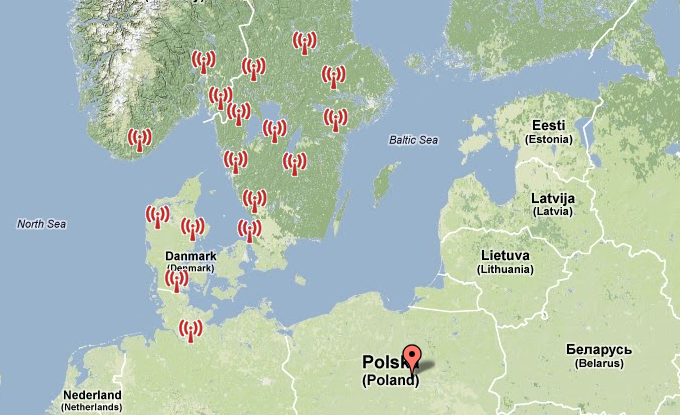Yesterday I noticed a very weak station on 91.2 and after a while I realised it is a Swedish voice. However the antenna direction was wrong, it was heading Lithuania, Latvia and Estonia. Well… everything was clear – finally first reception via auroral propagation for me! The best signal strength was around 16 UTC with an antenna aimed at 0-30° azimuth.

Lots of stations came up, but identification was quite difficult due to a distorted and very fluttery signal. Emel has helped me with some of them, thanks!
| Freq | Station | Location | ERP [kW] |
Distance |
| 87.6 | NDR 2 | D Hamburg – Moorfleet | 80 | 654 |
| 88.1 | DR P1 | DNK Århus – Søsterhøj | 60 | 731 |
| 88.7 | NRK P1 | NOR Oslo – Tryvann | 90 | 994 |
| 88.8 | NRK P1 | NOR Greipstad – Eidsåveg | 57.5 | 976 |
| 88.9 | SR P1 | S Skövde – Billingen TM | 60 | 748 |
| 89.1 | NRK P2 | NOR Halden – Høyåsmasten | 72.5 | 897 |
| 89.3 | SR P1 | S Göteborg – Brudaremossen TM | 60 | 749 |
| 89.4 | SR P1 | S Borlänge – Teracoms mast Idkerberget | 60 | 912 |
| 89.6 | SR P1 | S Nässjö – Teracom mast Berg | 60 | 649 |
| 89.8 | SR P1 | S Helsingborg – Olympia TM | 30 | 598 |
| 90.0 | SR P1 | S Norrköping – Kolmården-Krokek Orrbergen TM | 60 | 709 |
| 90.2 | DR P1 | DNK Holstebro – Mejrup | 60 | 831 |
| 90.7 | SR P1 | S Västerås – Lillhärad TM | 60 | 812 |
| 90.9 | SR P1 | S Sunne – Blåbärskullen TM | 60 | 911 |
| 91.2 | SR P2 | S Halmstad – Oskarström-Slättåkra TM | 60 | 640 |
| 91.7 | DR P3 | DNK Århus – Søsterhøj | 60 | 731 |
| 92.7 | SR P2 | S Bäckefors (Mellerud) – Grönehög TM | 60 | 838 |
| 92.9 | DR P3 | DNK Holstebro – Mejrup | 60 | 831 |
| 93.2 | NDR 2 | D Flensburg – Engelsby | 25 | 718 |
The obtained distances are comparable to a fairly good tropospheric ducting opening. Furthermore, some of these stations can be received every day with an airplane scatter mode (i.e. Göteborg, Århus and other closer transmitters). The main difference is a signal quality, because tropospheric signals can reach stereo & RDS reception and aurora cannot due to doppler shifts. The wider bandwidth, the more distorted audio is. FM is not really suitable for this propagation mode, however a very fluttery sound could be heard. A real signal distance is significantly higher because of the propagation mode – backscatter. Signals are reflected back from the aurora zone and optimal azimuth is not the same as the direction to a particular location.
The aurora was as well visible as audible in Poland. Unfortunately I haven’t seen it at my QTH.
Check some photos here.
